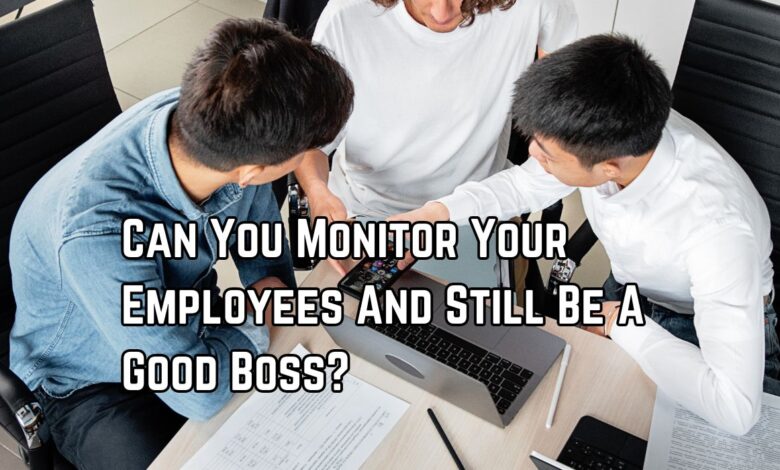Can You Monitor Your Employees And Still Be A Good Boss?
Explore the balance between employee monitoring and maintaining trust. Discover how good leadership can include supervision without overstepping.

60% of companies with remote workers use monitoring software to monitor employee productivity. The issue of employee monitoring has become increasingly prevalent. With advancements in technology, employers now have the capability to closely monitor their employees’ activities, both online and offline. But is it OK to monitor your employee? However, this raises an important question: Can you monitor your employees and still be a good boss?
The answer isn’t a simple yes or no; rather, it requires a nuanced understanding of the balance between monitoring and trust, accountability, privacy, and the overall well-being of employees.
Understanding Employee Monitoring in Depth
Employee monitoring refers to the use of various technologies and tools by employers to observe and track employees’ activities. This can include monitoring internet usage, email communications, phone calls, location tracking, and even surveillance cameras in the workplace.
Pros of Employee Monitoring
Increased Productivity: Proponents argue that monitoring can identify inefficiencies in processes and workflows. It can help business owners to monitor the activities of the employees. As a result, it becomes easy to evaluate their performance.
Security: Monitoring can also help prevent security breaches, such as unauthorized access to sensitive data. Some companies even monitor the phones, laptops and mails to ensure security.
Compliance: Regular monitoring reduces the likelihood of legal liabilities by ensuring employees follow policies, regulations, and laws. It helps to maintain a proper work policy among the staffs.
Performance Evaluation: Monitoring provides objective data for performance evaluations. It allows managers to provide constructive feedback and identify areas for improvement. As we mentioned before the best part about monitoring you can evaluate the performance of the employees.
Cons of Employee Monitoring:
Global demand for the employee monitoring software has increased by 65%. It is a matter of concern. Why? More than 63% percent of organization is using new tools for collecting employees data. Here’s what are the cons of using employee monitoring softwares.
Invasion of Privacy: Critics argue that excessive monitoring can infringe upon employees’ privacy rights, leading to feelings of distrust and resentment. The employees feel constantly watched. Just imagine yourself in the exam hall with the teacher standing next to you, would you be able to write freely? The same is true for employees.
Decreased Morale: Constant monitoring can create a culture of micromanagement. It leads to decreased morale, job dissatisfaction, and increased stress among employees. The most annoying part of employee monitoring is this part. You cann’t take s small action while being monitored. Isn’t it frustrating?
Negative Impact on Creativity: A rigid monitoring environment may stifle creativity and innovation. Employees may feel hesitant to take risks or think outside the box. It prevents employees to become creative.
Potential for Abuse: Without proper oversight, monitoring systems can be abused by employers to exert undue control over employees or engage in discriminatory practices.
Striking a Balance:
The key to being a good boss while monitoring employees lies in striking a balance between oversight and trust. Here are some strategies to achieve this balance:
Transparent Communication: Clearly communicate to employees the purpose and extent of monitoring practices. Transparency fosters trust and ensures that employees understand the rationale behind monitoring measures. Create a guideline for monitoring
- Privacy concerns
- Data security measures
- Limitations of monitoring
- The aims of the exercise
- Laws and regulations that apply to your jurisdiction
Focus on Outcomes: Instead of monitoring every minute detail of employees’ activities, focus on outcomes and results. Trust employees to manage their time and tasks effectively, while providing support and guidance as needed. You have to choose a perfect monitoring software to get the best results. The software should do the work you need without collecting any data that is not related to your task. The best monitoring software help you in
- Real time monitoring
- You get productivity matrices to evaluate the employees.
- Take screenshots
- App/ website usage monitoring
- Customize privacy setting is available for the employers. So that you can uncivilized the settings according to your needs.
Respect Privacy: Respect employees’ privacy rights by implementing monitoring measures that are proportionate to the objectives and minimize intrusiveness. Avoid excessive surveillance and ensure that monitoring is conducted in a non-invasive manner. It is likely to make them frustrated with their work in the long run.
Empowerment and Autonomy: Empower employees by providing them with autonomy and decision-making authority in their roles. Trusting employees to take ownership of their work fosters a sense of responsibility and accountability.
Feedback and Support: Instead of using monitoring solely for evaluation purposes, use it as a tool for providing constructive feedback and support. Encourage open communication and dialogue, and be responsive to employees’ concerns and feedback.
Distrust Between Employees And Management
Installing monitoring software is the first step; tracking and analyzing collected data is the next. Data analysis is typically handled by the manager, which means additional responsibilities. Make sure the manager schedules a training session for the team so they know what to expect. You have to more focus on management rather than tracking the employees.
A lack of clear communication about surveillance can lead to mistrust among employees. The employer may not trust them to do their job or suspect something shady about them. A situation like this may negatively affect. You need to create a working environment. It will help you grow your business, whether you run an in-house business or a remote company.
Conclusion: Monitor Your Employees And Still Be A Good Boss
The question of whether you can monitor your employees and still be a good boss is not a matter of black and white. It requires a careful consideration of various factors, including trust, accountability, privacy, and employee well-being.
By striking a balance between monitoring and empowerment, communication you can create a positive work environment that fosters productivity, trust, and mutual respect. Ultimately, being a good boss is not about exerting control, but rather about empowering and supporting employees to thrive and succeed.





